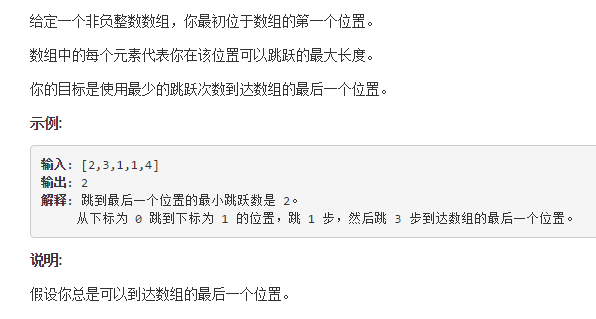
开始打算直接用递归来做,实现后发现超时了,代码如下:
int Min(int a, int b) { return a > b ? b : a; } void jump_helper(vector<int>& nums, int start, int count, int ¤t_min) { int length = nums.size(); if (start >= length-1) { current_min = Min(current_min, count); return; } for (int steps = 1; steps <= nums[start]; steps++) { jump_helper(nums, start + steps, count + 1, current_min); } } int jump2(vector<int>& nums) { int length = nums.size(); int count = 0; int min = INT_MAX; jump_helper(nums, 0, count, min); return min; }
其实可以用贪婪法来做,找到可以到达最远的下一个点,作为更新的点,不停找下去,直到跳走。
需要考虑只有一个数为0的情况,此时return 0.
int Max(int a, int b) { return a > b ? a : b; } int jump(vector<int>& nums) { int length = nums.size(); int count = 0; if (length < 2) return 0; for (int pos = 0; pos < length ; ) { int next = pos; int current_pos = pos; for (int i = 0; i <= nums[pos]; i++) { if (pos + i >= nums.size() - 1) return ++count; if (pos + i + nums[pos + i]> next) { next = pos + i + nums[pos + i]; current_pos = pos + i; } } pos = current_pos; count++; } return count; }




















 481
481

 被折叠的 条评论
为什么被折叠?
被折叠的 条评论
为什么被折叠?








